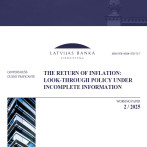The reducing influence of commodities prices on inflation is slowing
According to the data of the Central Statistical Bureau (CSB), the consumer price level also in October was lower than a year ago (the annual inflation in October was -0.2%). Inflation was curtailed by the global commodities prices, but their downward impact on inflation in Latvia could diminish somewhat in the coming months. The population sentiment regarding the financial situation of households, savings and large purchases has slightly improved and the expectations of higher prices have also diminished.
Oil prices in the global market remained relatively stable in October and the month-on-month drop in fuel prices contracted to 1.8%. With the global energy prices stabilizing, there are no signals about any further drops in, for instance, prices of natural gas or heating energy in the domestic market.
In the world food market, however, there are signals about the weather conditions prevailing in the Southern hemisphere, which have had a negative impact on livestock farming for several months and might have a negative effect on the harvest. For this reason, there were more groups of food products in October (compared to September), in which prices rose. According to the data of the Food and Agriculture Organization (FAO), until August 2015, food prices continued to gradually drop after the maximum reached in 2011 and went down to the level last observed in the second quarter of 2009. Thus a relatively low base level has formed for prices in this market. With the global economy experiencing moderate growth and with the downward impact of local factors (the European Union (EU) milk output quotas, trade sanction between the EU and Russia etc.) disappearing, food prices might rather begin to rise.
In October, the consumer food prices in Latvia already began to rise, with those of cereal products, fish products and eggs rising more substantially. Thus the better domestic cereal harvest has not resulted in a drop in prices. In other words, reacting to either the global factors or purchasing power of the population, food prices have slightly increased.
In October, the new heating season began, which is often accompanied by pessimism of the population regarding the price level dynamic. However, after the September discussion on indirect raising of taxes in the context of the 2016 budget, in October, the reminders on the part of AS "Rīgas siltums" as to how low the heating energy prices are at the beginning of this heating season (as opposed to a year ago) became topical. That may have affected the population sentiment reflected in surveys on the evaluation of expected purchases and price level dynamic. The new electrical power price offers for 2016, with a slightly lower market component, are working in a similar direction. According to the European Commission data, the population viewed the possibilities of saving or making larger purchases slightly more hopefully. Likewise, they placed more hope in the future dynamic of the financial situation of their household. There were fewer of those who would expect a rapid rise in prices in the next 12 months.
The sentiment indicators of a single month of course should not be literally related either to growth indicators of either trade or service branch or to price trends in these segments. Yet the stable goods price level or even a year-on-year drop in the prices of various everyday items (food, fuel) should still be placed among the reasons why the year-on-year rise in service prices is faster. Despite the optimism and possible readiness of the population to spend more as well as the rise in the prices of seasonal wearing apparel and footwear characteristic of September and October, the prices of wearing apparel had experienced such great drops since previous autumn/winter season that the seasonal rise in prices, which has been even faster than in previous years does not amount to a positive annual rise in this group. The annual core inflation in October was maintained by the rise in prices of various tradable non-food items and some services (for instance, technological goods, goods and services related to routine household maintenance as well as goods related to recreation and culture, books and stationery). It can be expected in 2016 as well that the components of core inflation -- the price trends of unregulated service prices and manufactured goods -- will account for most of the inflation and that the impact of the low prices of global resources will diminish.
Textual error
«… …»






